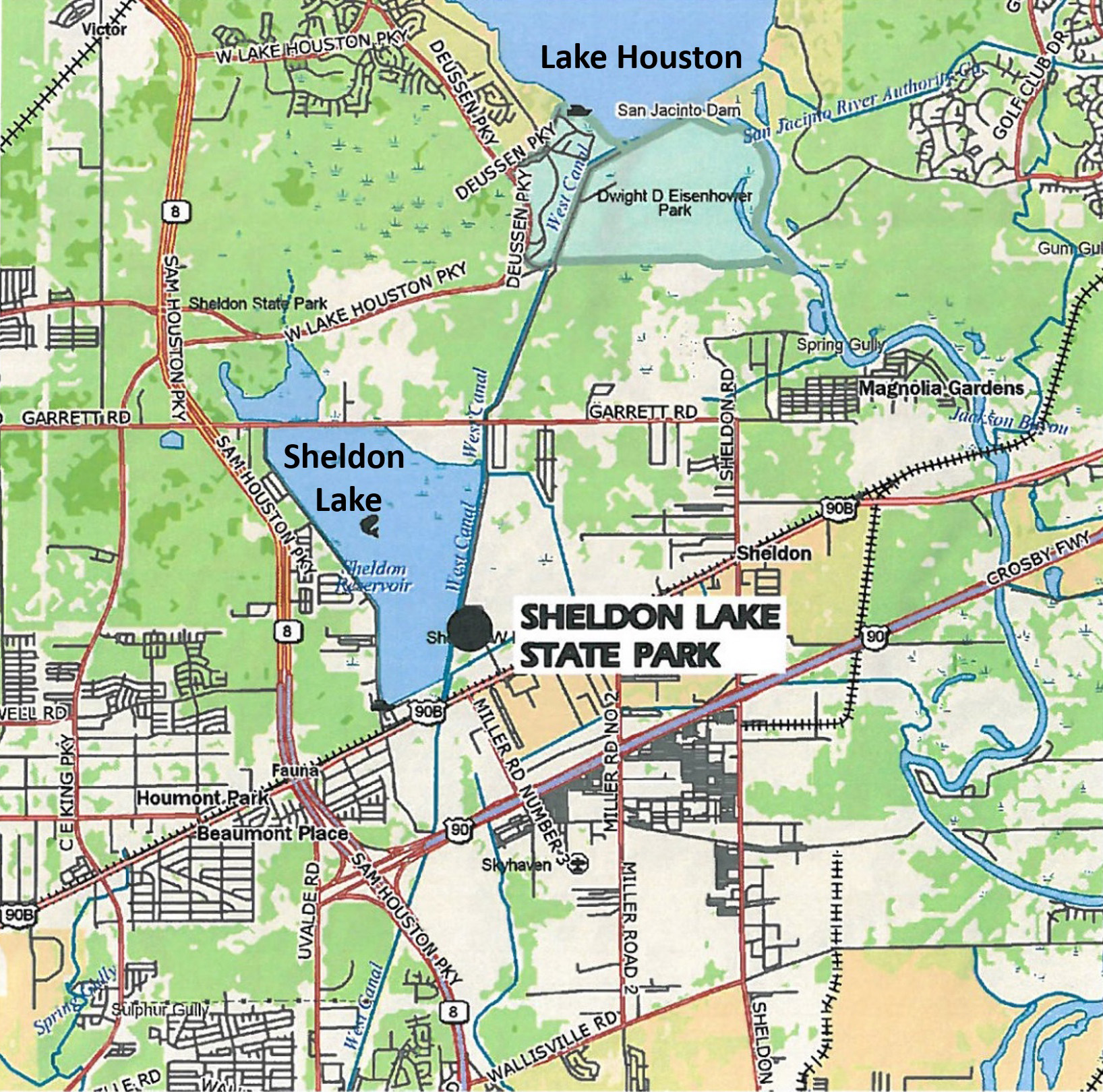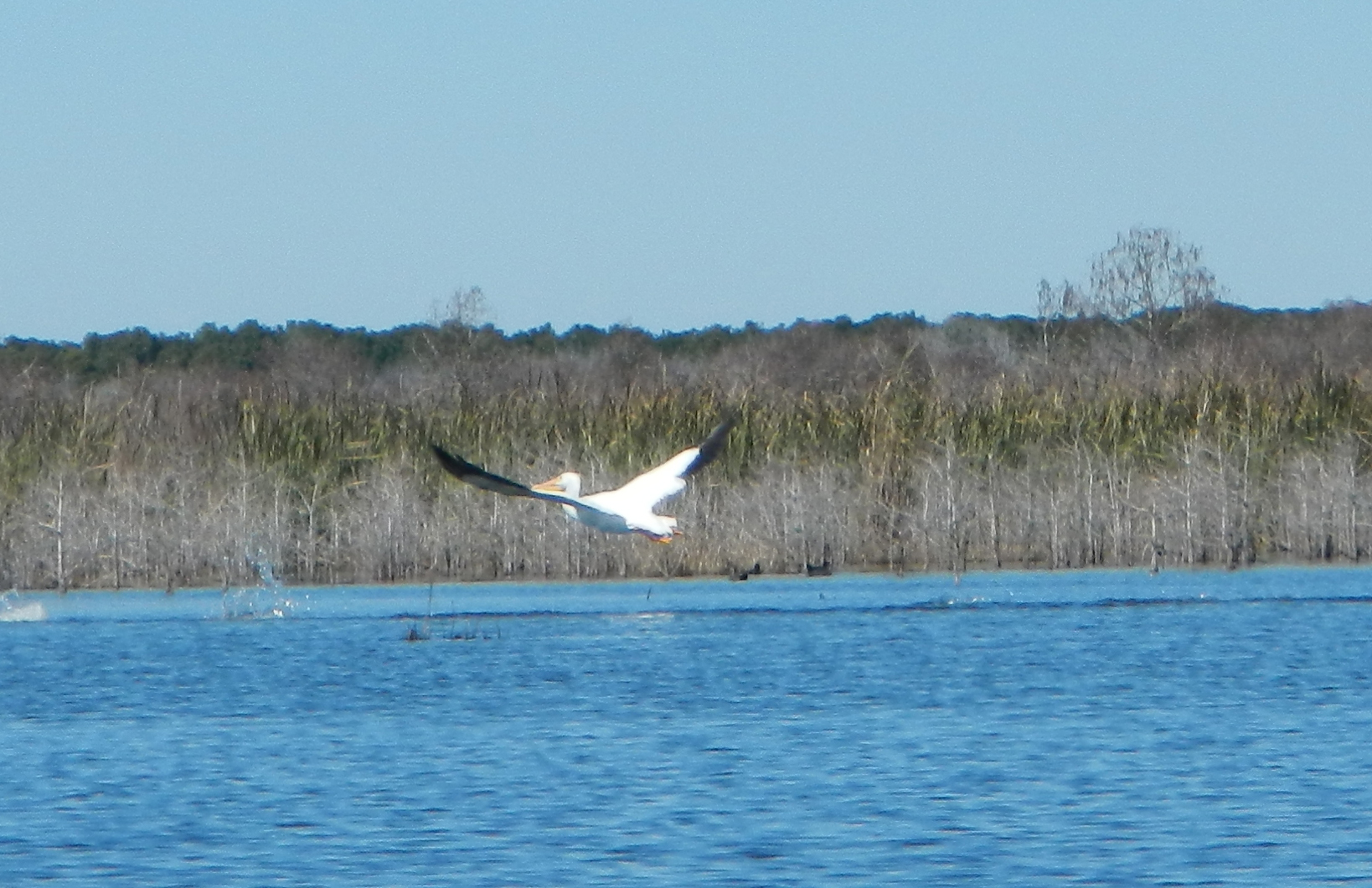By Tom Douglas
In an earlier article, Kristy Key described what can be seen during a visit to the boardwalks and observation platforms on the east side of the 2,800-acre Sheldon Lake State Park and Environmental Learning Center. Here, I will focus more on Sheldon Lake itself, and on how the park took on its current form.
 Sheldon Lake covers over 1,200 acres and has a noticeably geometrical shape. About two-thirds of it is open water, while the remainder is forested or brushy. And there are many small islands that are clearly arranged into straight lines. Click here to take a quick virtual tour around the lake by air.
Sheldon Lake covers over 1,200 acres and has a noticeably geometrical shape. About two-thirds of it is open water, while the remainder is forested or brushy. And there are many small islands that are clearly arranged into straight lines. Click here to take a quick virtual tour around the lake by air.
To help us understand how this unusual set of features came about, let’s begin with an account from the Texas Water Development Board.
“Sheldon Reservoir is located two miles southwest of Sheldon and 16 miles east of downtown Houston in Harris County, on Carpenters Bayou, a tributary of the San Jacinto River. The reservoir was created in 1943 when the federal government built a dam to provide fresh water for shipbuilding and shipping industries on the Houston Ship Channel during World War II. After the war, management of the reservoir was assumed by the City of Houston. The city sold water to ship-channel industries until 1953, when that supply was replaced by water from Lake Houston.
In 1952, after the construction of the dam that creates Lake Houston, the city sold the reservoir to the Texas Parks and Wildlife Department for use as a waterfowl sanctuary and public fishing site. In 1984, land around the reservoir was designated the Sheldon State Wildlife Management Area, with funds allocated by the Sixty-seventh Texas Legislature. The reservoir is almost three miles long and is more than a mile wide. It drains an area of about 19 square miles. The ten-foot-high earth embankment, Sheldon Dam, has a spillway crest elevation of 50.5 feet above mean sea level. The reservoir has a capacity of 4,224 acre-feet and covers 1,244 acres, at this elevation.”
Up until the early 1900s, the land now occupied by the Sheldon Lake State Park and Environmental Learning Center was coastal tallgrass prairie, bisected from east to west by a low ridge that had once been a natural river levee. Eventually, this complex patchwork of numerous “mima mounds” and small depressional wetlands was flattened out to facilitate agriculture.
With the construction of Sheldon Lake during the 1940s, the prairie was inundated. Then, in the 1950s, the eastern portion of the lake was drained for construction of the West Canal, which delivers water from Lake Houston down to the City of Houston’s East Water Purification Plant and also to ship channel industries. The eastern shore of the lake is now defined by the straight, concrete-lined structure of the West Canal, and the straight-line banks on the south and west sides of the lake are formed by sections of the earthen Sheldon Dam. Before the water that passes over the dam’s spillway can continue on down Carpenters Bayou, it must pass above an underground stretch of the West Canal. Eventually, it will reach the confluence with Buffalo Bayou, near the berth for the Battleship Texas.
Starting in the 1990s, a novel restoration project was planned to restore wet prairie habitat to the now re-exposed area east of the lake. The guiding principle of the approach (now often referred to as the “Sheldon-Sipocz method”) was to begin by re-discovering the original mound-and-depression landforms by using aerial photographs and detailed topographical maps from the 1920s and 1930s. Excavation of the former ponds, at their same locations and to their original depths, exposed soils that would support wetland plants, and the locations of the restored depressions within the surrounding landscape allowed them to collect rain water that ran off from the surrounding prairie. The re-excavated depressions were then planted with local native wetland plants. The planting phase of the restoration project was completed by the Wetland Restoration Team, a collaborative effort between the Texas Master Naturalists, Texas A&M AgriLife Extension Service, and Texas Sea Grant. This approach is now being used as a model for projects across the nation.
 So, the next time that you are at Sheldon Lake, you might want to visit the Environmental Learning Center’s extensive boardwalks and the 82-foot John Jacob Observation Tower near the east side of the lake. From there, you can get a sweeping view of the lake, hiking trails, and restored wet prairie. Before you head out for your visit, you might also want to check out this short video that describes how Sheldon Lake State Park is a successful example of “Green Infrastructure.” (The video clip that is specific to Sheldon Lake starts at 1:25.) The Environmental Learning Center’s website is a great source for more about the park, such as a trail map, interpretive guide, birding list, and contact information.
So, the next time that you are at Sheldon Lake, you might want to visit the Environmental Learning Center’s extensive boardwalks and the 82-foot John Jacob Observation Tower near the east side of the lake. From there, you can get a sweeping view of the lake, hiking trails, and restored wet prairie. Before you head out for your visit, you might also want to check out this short video that describes how Sheldon Lake State Park is a successful example of “Green Infrastructure.” (The video clip that is specific to Sheldon Lake starts at 1:25.) The Environmental Learning Center’s website is a great source for more about the park, such as a trail map, interpretive guide, birding list, and contact information.
Special thanks to Drew Molly, P.E., Director, Drinking Water Operations at the City of Houston Public Works and Engineering Department for help with research on the West Canal and the East Water Purification Plant.